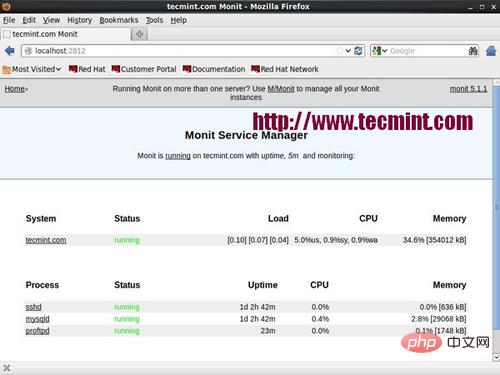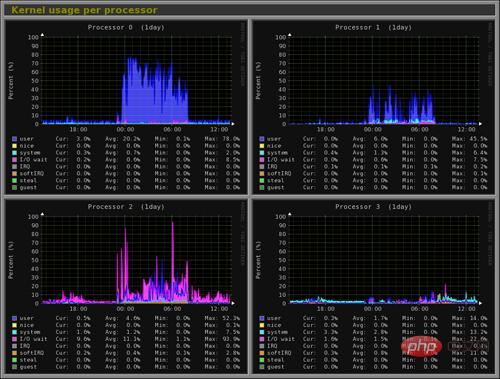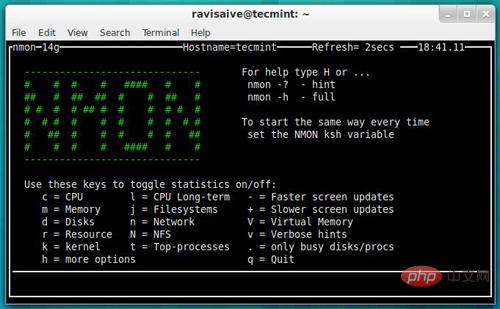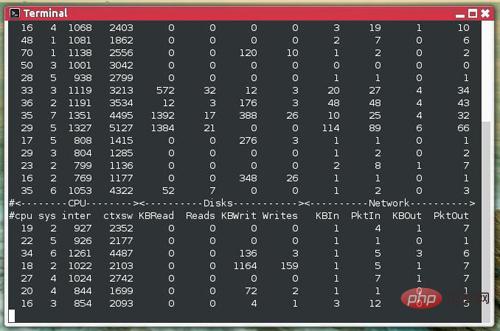 Operation and Maintenance
Operation and Maintenance
 Linux Operation and Maintenance
Linux Operation and Maintenance
 What are the linux monitoring software?
What are the linux monitoring software?
What are the linux monitoring software?
Linux monitoring software includes: 1. Monit, used for program and service monitoring; 2. NetHogs; 3. Monitorix; 4. Arpwatch; 5. Suricata; 6. VnStat PHP; 7. Nagios; 8. Nmon ; 9. Collectl and so on.

#The operating environment of this tutorial: linux5.9.8 system, Dell G3 computer.
9 Commonly Used Linux Performance Monitoring Tools
1. Monit - Program and Service Monitoring
This is a free and open source web-based program. Automatically monitor and manage system processes, programs, files, directories, permissions, and verify file systems. Services it monitors include Apache, MYSQL, Mail, FTP, Nginx, and more. System status can be viewed from the command line or your own network interface.

2. NetHogs - Monitor the network bandwidth of each process
NetHogs is a beautiful open source small program (similar to top command on Linux), maintains network activity for each process on your system. It also maintains real-time network traffic bandwidth usage of a program or application.

3. Monitorix - system and network monitoring
Monitorix is as much a lightweight tool as possible on Linux/Unix Level monitoring tool, mainly designed to monitor running systems and network resources. It has a built-in HTTP web service to regularly collect system and network information and display it as pictures. It can monitor the system's average load usage, memory allocation, disk drives, system services, network ports, mail statistics (Sendmail, Postfix, Dovecot, etc.), MYSQL database and many more services. Its main purpose is to monitor the performance of the entire system and helps detect faults, bottlenecks, abnormal activities, etc.

4. Arpwatch - Ethernet activity monitor
Arpwatch is a network used to monitor the Ethernet network of Linux networks A program that performs geocoding (network address translation) of traffic. It constantly monitors Ethernet traffic and generates logs of IP and MAC address pairs as network timestamps change. When an IP address or MAC address pair changes, it will send an email to notify the administrator.
And, it is very useful in detecting ARP attacks.
5. Suricata - Network Security Monitoring
Suricata is a high-performance open source network security and intrusion detection and prevention monitoring system for Linux, FreeBSD, Windows and other operating systems. tool. It is owned by a non-profit foundation OISF (Open Information Security Foundation).
6. VnStat PHP - Monitor network bandwidth
VnStat PHP is a web front-end application with the most popular social tool called "vnstat". VnStat PHP uses a nice graphical mode to monitor network traffic usage. It shows network traffic usage in hourly, daily, and monthly summary reports.
7. Nagios - Network/Server Monitoring
Nagios is a leading open source powerful monitoring system for network/system administrators before they affect major business processes. Identify and resolve server-related issues. Nagios can monitor remote Linux, Windows, switches, single-window routers, and printers. It displays critical alerts on your network and servers, helping you solve problems before errors occur.
8. Nmon - Monitor Linux system performance
Nmon (Nigel Performance Monitor) tool is used to monitor all resources of the Linux system including: CPU, memory, Disk usage, processes on the network, NFS, kernel, etc. This tool has two modes: online mode and capture mode. The online mode is suitable for real-time monitoring, and the capture mode is used for processing after storing the output in CSV format.

9. Collectl - integrated performance detection tool
Collectl is another powerful command line-based monitoring tool. It can be used to collect information about system resources, including CPU usage, memory, network, nodes, processes, NFS, TCP sockets, and more.

We would like to know what kind of monitoring program you use to monitor your server performance? If we missed any tools you would like, please let us know in the comments and don't Forgot to share him.
Related recommendations: "Linux Video Tutorial"
The above is the detailed content of What are the linux monitoring software?. For more information, please follow other related articles on the PHP Chinese website!

Hot AI Tools

Undresser.AI Undress
AI-powered app for creating realistic nude photos

AI Clothes Remover
Online AI tool for removing clothes from photos.

Undress AI Tool
Undress images for free

Clothoff.io
AI clothes remover

Video Face Swap
Swap faces in any video effortlessly with our completely free AI face swap tool!

Hot Article

Hot Tools

Notepad++7.3.1
Easy-to-use and free code editor

SublimeText3 Chinese version
Chinese version, very easy to use

Zend Studio 13.0.1
Powerful PHP integrated development environment

Dreamweaver CS6
Visual web development tools

SublimeText3 Mac version
God-level code editing software (SublimeText3)

Hot Topics
 What computer configuration is required for vscode
Apr 15, 2025 pm 09:48 PM
What computer configuration is required for vscode
Apr 15, 2025 pm 09:48 PM
VS Code system requirements: Operating system: Windows 10 and above, macOS 10.12 and above, Linux distribution processor: minimum 1.6 GHz, recommended 2.0 GHz and above memory: minimum 512 MB, recommended 4 GB and above storage space: minimum 250 MB, recommended 1 GB and above other requirements: stable network connection, Xorg/Wayland (Linux)
 Linux Architecture: Unveiling the 5 Basic Components
Apr 20, 2025 am 12:04 AM
Linux Architecture: Unveiling the 5 Basic Components
Apr 20, 2025 am 12:04 AM
The five basic components of the Linux system are: 1. Kernel, 2. System library, 3. System utilities, 4. Graphical user interface, 5. Applications. The kernel manages hardware resources, the system library provides precompiled functions, system utilities are used for system management, the GUI provides visual interaction, and applications use these components to implement functions.
 How to run java code in notepad
Apr 16, 2025 pm 07:39 PM
How to run java code in notepad
Apr 16, 2025 pm 07:39 PM
Although Notepad cannot run Java code directly, it can be achieved by using other tools: using the command line compiler (javac) to generate a bytecode file (filename.class). Use the Java interpreter (java) to interpret bytecode, execute the code, and output the result.
 vscode cannot install extension
Apr 15, 2025 pm 07:18 PM
vscode cannot install extension
Apr 15, 2025 pm 07:18 PM
The reasons for the installation of VS Code extensions may be: network instability, insufficient permissions, system compatibility issues, VS Code version is too old, antivirus software or firewall interference. By checking network connections, permissions, log files, updating VS Code, disabling security software, and restarting VS Code or computers, you can gradually troubleshoot and resolve issues.
 Can vscode be used for mac
Apr 15, 2025 pm 07:36 PM
Can vscode be used for mac
Apr 15, 2025 pm 07:36 PM
VS Code is available on Mac. It has powerful extensions, Git integration, terminal and debugger, and also offers a wealth of setup options. However, for particularly large projects or highly professional development, VS Code may have performance or functional limitations.
 How to check the warehouse address of git
Apr 17, 2025 pm 01:54 PM
How to check the warehouse address of git
Apr 17, 2025 pm 01:54 PM
To view the Git repository address, perform the following steps: 1. Open the command line and navigate to the repository directory; 2. Run the "git remote -v" command; 3. View the repository name in the output and its corresponding address.
 How to use VSCode
Apr 15, 2025 pm 11:21 PM
How to use VSCode
Apr 15, 2025 pm 11:21 PM
Visual Studio Code (VSCode) is a cross-platform, open source and free code editor developed by Microsoft. It is known for its lightweight, scalability and support for a wide range of programming languages. To install VSCode, please visit the official website to download and run the installer. When using VSCode, you can create new projects, edit code, debug code, navigate projects, expand VSCode, and manage settings. VSCode is available for Windows, macOS, and Linux, supports multiple programming languages and provides various extensions through Marketplace. Its advantages include lightweight, scalability, extensive language support, rich features and version
 vscode terminal usage tutorial
Apr 15, 2025 pm 10:09 PM
vscode terminal usage tutorial
Apr 15, 2025 pm 10:09 PM
vscode built-in terminal is a development tool that allows running commands and scripts within the editor to simplify the development process. How to use vscode terminal: Open the terminal with the shortcut key (Ctrl/Cmd). Enter a command or run the script. Use hotkeys (such as Ctrl L to clear the terminal). Change the working directory (such as the cd command). Advanced features include debug mode, automatic code snippet completion, and interactive command history.





